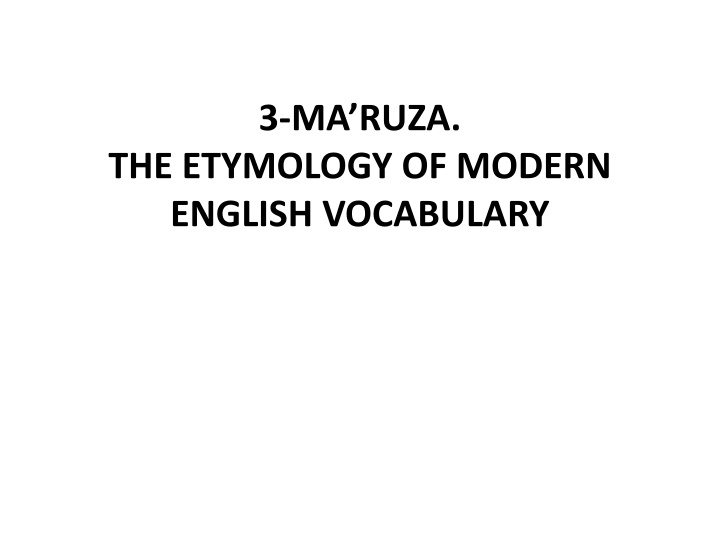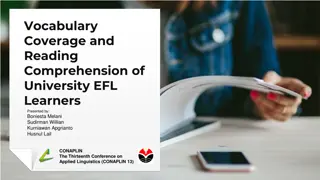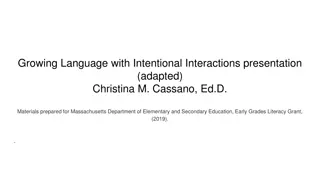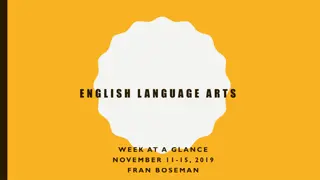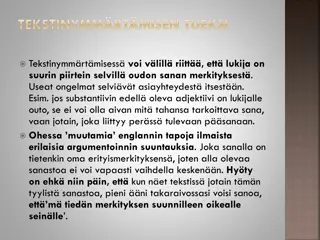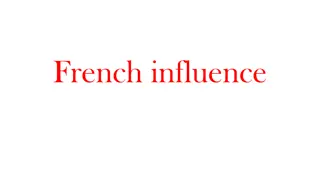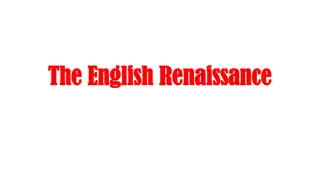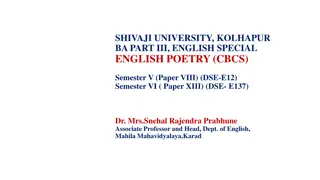The Etymology of Modern English Vocabulary: A Detailed Analysis
The etymology of modern English vocabulary explores words of native Anglo-Saxon origin, Germanic borrowings, and English elements, examining their characteristics and assimilation into the language. It delves into the ways borrowing occurs, criteria for assimilation, and the distinct layers comprising the English vocabulary. The process of borrowing, whether oral or written, has shaped the richness and diversity of the English language over time.
Download Presentation

Please find below an Image/Link to download the presentation.
The content on the website is provided AS IS for your information and personal use only. It may not be sold, licensed, or shared on other websites without obtaining consent from the author.If you encounter any issues during the download, it is possible that the publisher has removed the file from their server.
You are allowed to download the files provided on this website for personal or commercial use, subject to the condition that they are used lawfully. All files are the property of their respective owners.
The content on the website is provided AS IS for your information and personal use only. It may not be sold, licensed, or shared on other websites without obtaining consent from the author.
E N D
Presentation Transcript
3-MARUZA. THE ETYMOLOGY OF MODERN ENGLISH VOCABULARY
1. 1. Words of native origin and their characteristics 2. Ways of borrowing into English 3. Criteria and assimilation of borrowings 4. Special type of borrowings
2 1. Words of native origin and their characteristics The native element of the English Vocabulary is composed of words of Anglo-Saxon origin brought to the British Isles from the continent in the fifth century by the Germanic tribes ( ): the Angles, the Saxons, the Jutes, and some words coined ( ) in English later. They are subdivided into: 1. Words of the Indo-European stock; 2. Words of the common Germanic stock; 3. English words proper
3. The words having parallels in the vocabularies of different Indo-European languages form the oldest layer. Ex. English star, German Stern, Latin Stella, Greek Aster. The words of Indo-European stock (IES) fall into definite semantic group: 1. Terms of kingship ( ): father, mother, daughter. 2. Natural phenomena (Sun, Moon, star, wind, storm) 3. Names of animals and birds (horse, goose) 4. Parts of human body (heart, eye) 5. Qualities and properties (old, young, cold) 6. Common actions (come, sit, stand)
4. A much bigger part of the native vocabulary is formed by words of the common Germanic stock, that is words having parallels in German, Norwegian, Dutch, and Icelandic. Ex. En: Summer and winter Germ: Sommer/Winter) The English elements proper is specifically English having no cognates in other languages. Ex. Lady, always, girl, lord, daisy, boy.
5. 2. Ways of borrowing into English. A loan word or a borrowing is a words taken over from another language and modified in phonemic shape, spelling paradigm or meaning according to the standards of the English language.. Borrowings can enter the languages in 2 ways: 1. Through oral speech (by immediate contact between peoples) 2. Through written speech (by indirect contact through books)
6. Oral borrowings took place mainly in the early periods of history (old borrowings from Latin: inch, mill, street). They are usually short and undergo more changes in the act of adoption. Written speech (French belles-lettres) preserve their spelling, They are often rather long and their assimilation is a laborious process.
7. 3. Criteria and assimilation of borrowings The criteria of borrowings are: 1. Certain pronunciation and spelling (psychology Greek, machine French) 2. Unusual morphological structure and grammatical forms (ex. Pl. bacteria Sg. Bacterium Latin) 3. Specific lexical meaning (ex,. Pagoda, rickshaw Chinese)
8. Borrowed words are assimilated in 3 main ways: 1. Phonetic assimilation comprising changes in the sound, form and stress ( ). Ex. Germ. Spitz / English Spitz. 2. Grammatical assimilation causing the loss of former grammatical categories and affixes and the acquirement ( ) of new paradigms (ex. Latin Botanicus was turned into English Botanical) 3. Semantic assimilation comprising adjustment ( ) to the system of meaning of the vocabulary (ex. Gay was borrowed from French with several meaning noble of birth, bright shining, multicolored. Now it means joyful or high-spirited.
9. According to the degree of assimilation loan words fall into 3 groups: 1. Completely assimilated words that follow all morphological, phonological and orthographical standards of the receiving language (French pain is readily combined with native affixes pained, painful, painless)
10. 2. Partially assimilated words: - Not assimilated semantically, because they denote objects and notions peculiar to a certain country (ex. Sombrero) - Not assimilated grammatically (ex. Borrowings from Latin/Greek: formula/ae) - Not assimilated phonetically (prestige, memoir French) - Not assimilated graphically (ex. The final silent t in ballet French)
11. 3. Barbarisms words from other languages used by English people in conversation or in writing but not assimilated in any way for which there are corresponding English equivalents (ex. Chaos, adios).
12. 4. Special types of borrowings The changes which a loan word had to undergo depending on the date of its penetration are the main cause for the existence of the so-called etymological doublets. Etymological doublets are pairs of words, which have one and the same original form, but which have acquired different forms and even different meaning during the course of linguistic development. (ex. The words shirt and skirt etymologically descend from the same root. Shirt is a native words, skirt is a Scandinavian borrowing. Their phonetic shape is different, and yet there is a certain resemblance ( ), which reflects their common origin. Their meanings are also different but easily associated: they both denote articles of clothing.
13. Words of identical origin can accrue in several languages as the result of simultaneous or successive ( ) borrowings from one ultimate source, these words are called international words (ex., gene, antibiotic).
Check yourself What is the subdivision of the native origin of English word stock? What semantic groups do the words of Indo- European stock include? Can you give the examples of the English elements proper? What is the borrowing and how it enters the language? What are the 3 main ways of assimilation of a borrowed word?
